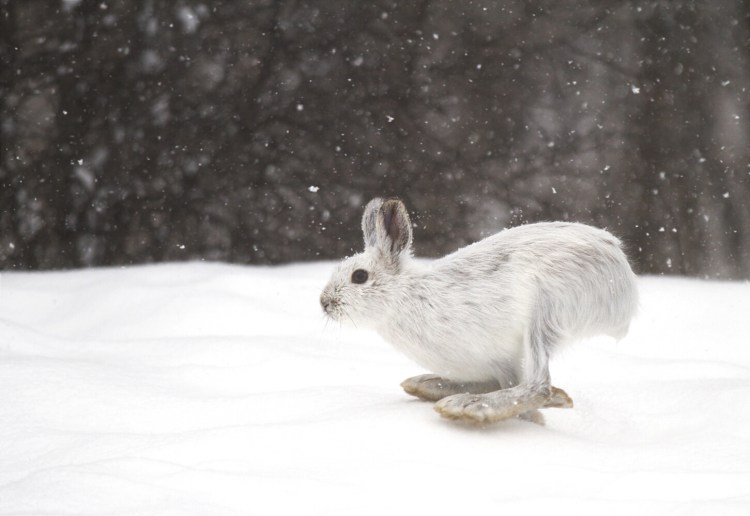With the end of muzzleloader and expanded archery seasons, deer hunting is now officially over for another year. White-tailed deer are far and away the most popular game species in Maine, and everywhere else they occur, most hunters will put away their guns, bows, ammo and arrows and switch to ice fishing, snowmobiling or other outdoor pursuits. But a few bold lads and lasses will simply switch gear and perpetuate their pursuit of prey and protein.
Snowshoe hare season runs through March 31 over most of the state. Chasing wild hares becomes more challenging now as their pelage has changed from brown to white, allowing them to blend into a snowy backdrop. But the broad, powerful feet from which they derive their name have a couple Achilles’ heels.
Occasionally, Mother Nature plays a nasty trick in the form of a mid or even late winter thaw. When the white woods change to brown, snowshoes suddenly stand out against the dark background making them easier to spy. Unfortunately for them, they don’t realize it. Their strategy for predator avoidance involves two tactics: flight or fright. Should they choose the former, they may well elude us by ducking into a copse of jack firs. But if they freeze, intending to avoid detection, they could fall victim to a stealthy, sharp-eyed woodsman.
They also tend to be home bodies, preferring to stay close to familiar habitat, a proclivity that can be exploited by hound hunters. When a hare is started by a keen-nosed beagle it will typically take off, running ahead of the hound. As it nears the boundaries of its home turf, the hare will sometimes circle back, and into the path of properly positioned hunters. More often than not, they elude both hunter and hound, but success is usually measured not in the bag brought home but in listening to the baying of the beagles.
Ruffed grouse, our No. 1 upland game bird, remain in season until year’s end, but it’s a different game now. In deep, powdery snow they’ll spend far less time on the ground, making it difficult for setters to sniff them out. Hunters must be more alert looking for the birds as they pick buds and catkins in the tops of birch and aspen trees, or as they suddenly launch from the limbs of a dense fir. The leaves are gone, allowing for more open shots, but the birds tend to be more wild and wary, often flushing well before hunter and dog are within range.
Crusty snow presents a potential opportunity, particularly after a good spell of wind. The birds can walk on top of the deep snow, and often will, as they seek out seeds blown out of the treetops. Unfortunately for the hunters, the crusty snow does make a stealthy approach more difficult, and is tougher on the dogs.
Waterfowl season lapses into the new year along the coast, which is where you’ll find most of these web-footed wild fowl in winter. With inland lakes, ponds and rivers frozen over, hardy species like blacks and mallards will congregate around river mouths, tidal marshes and rocky coastlines, where they can still dabble for food. But make no mistake, they’re now at their wariest and hunters must put extra attention into camo, concealment and realistic decoy spreads.
And for the hardiest of hunters, sea duck season lingers into mid January. In addition to the aforementioned attention to detail, hunters must also be extra mindful of safety. The ocean can be a perilous place in good weather, and even more formidable when the mercury falls to a level where salt spray and breath freeze solid on your face. But the gunning, when it’s good, can be red hot.
If none of the above fires your fancy, you might try calling in predators like fox, coyotes or bobcats. And there is no closed season on porcupines in Maine. I’ve heard varying reviews about their palatability, but you can rest assured there will be no shortage of toothpicks.
Bob Humphrey is a freelance writer and Registered Maine Guide who lives in Pownal. He can be reached at:
bhunt@maine.rr.com
Send questions/comments to the editors.



Comments are no longer available on this story